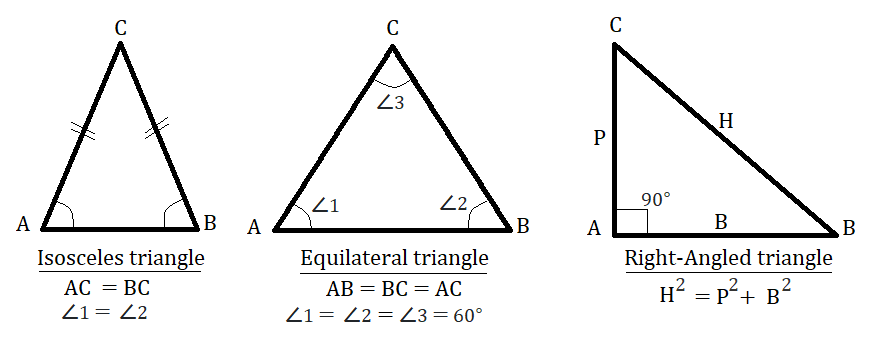Specific Properties
In this section, we will discuss properties related to specific triangles.
Isosceles Triangle:
• We have studied, in Isosceles Triangles any two sides are equal.
• Property: Angles opposite to equal sides are also equal. Its converse is also true.
Thus, if in a triangle two angles are equal the triangle is isosceles.
Equilateral Triangle:
• We have studied, in Equilateral Triangles all sides are equal.
• Property: All the Angles are also equal and their value is 60° (180°/3).
An equilateral triangle is an isosceles triangle but the converse is not true.
Right-Angled Triangle:
• The sides of this Right-Angled-triangle are usually named as Perpendicular (P), Base(B) & Hypotenuse (H), the hypotenuse is the longest side, as it is opposite to the angle 90°.
• Property: The sides of this triangle are according to the relation defined by the Pythagoras theorem.

Pythagoras theorem
What is Pythagoras theorem?
Pythagoras theorem states that “In a right-angled triangle, the square of the hypotenuse side is equal to the sum of squares of the other two sides“. \(H^2 = P^2 +B^2\)
The theorem can be easily proved and you can easily find thousands of resources proving it. Since the proof is very basic and not required in higher & competitive exams, we are skipping it.
What are Pythagorean triplets?
Integer triplets that satisfy Pythagoras equation, where the largest integer is treated as the hypotenuse factor.
♦ Though we do not support ratafication but you may try to learn or practice these Pythagoras triplets for fast calculation: -
(3, 4, 5), (5,12,13), (7, 24, 25), (8, 15, 17), (9, 40, 41), (11, 60, 61), (12, 35, 37), (13, 84, 85), (15, 112, 113), (16, 63, 65), (17,144, 145), (19, 180, 181), (20, 21, 29), (20, 99 ,101), (21, 220, 221)
How do these triplets help in the calculation?
Suppose you have the value P = 3.5, B = 8.4 & you have to calculate H in a right-angled triangle. Now, if you don't have any idea about these triplets you have to solve the equation from basic \(H^2 = P^2 +B^2\) ⇒ \(H^2 = 3.5^2 +8.4^2\) ⇒ H = \( \sqrt{3.5^2 +8.4^2} = \sqrt{82.81}\) ⇒ H = 9.1
- A lengthy calculation with the basic process
♦ With the triplets you can easily calculate H when P = 3.5, B = 8.4
P = 5 x 0.7 , B = 12 x 0.7, thus the factor value is 0.7 and the triplet is (5,12,13)
Hence, H = 13 x 0.7 = 9.1
Approach while applying these triplets?
Whenever you have to find any of the P, B or H when two of these values are given.
1) Check given two values can be part of the triplet. If yes, then the third value is as per triplet only. (while doing so remember that the largest value should be H only)
2) If they are not in triplet, find if there is any common factor in the given two values, if yes then write them in multiple of common factor.
3) Find the missing value if they are as per triplet. (example of the same has been given above.)
Few more examples.
Find B if P= 3.5, B= ?, H = 12.5
- Since, P and H are in decimal they cant be part of a triplet.
- Lets check after taking out common factors P = 3.5 = 7/2 and H = 25/2, thus common factor is 1/2. Now check triplet when P = 7 and B = 25. Thus we find they are from triplet 7, 24, 25. Hence we can conclude B = 24/2 = 12.
Note:- Even if you don't want to learn the triplet, you should make a habit of removing common factors while taking the square root of any no. like in the above example it is always easier to find B when the common factor (1/2) is removed.
Think which of the calculation is easier?? B = \(\sqrt{12.5^2-3.5^2}\) OR B = \({\sqrt{25^2-7^2} \over 2}\)
Full Syllabus in 1 Video [Contains Everything basic to advance]